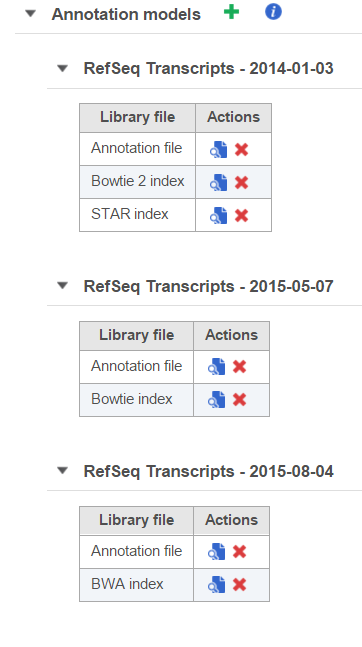Page History
The library files associated with the selected assembly are organized into several sections. Below is some information on each section.
| Table of Contents | ||
|---|---|---|
|
Reference Files
This section includes two types of library file: reference sequence and cytoband files.
...
Variant annotation databases from commonly used sources (e.g. dbSNP) are available for automatic download from the Partek repository. Because variant annotation databases are frequently updated, these sources are checked for updates quarterly. You can check for recent updates to the Partek repository on the Partek website here.
SnpEff variant databases
SnpEff1 is a variant annotation and effect prediction tool that requires its own variant annotation files, separate to the other Variant annotation library files. If you wish to use SnpEff, library files need to be added to this section.
VEP database
The Ensembl Variant Effect Predictor (VEP) is another variant annotation and prediction tool that requires its own annotation files, separate to the Variant annotation library files. If you wish to use VEP, library files need to be added to this section.
Annotation models
This section includes two types of library file: annotation models & aligner indexes.
...
Annotation models will appear in separate tables (Figure 2). If you have multiple versions of annotation models from the same source, it is advisable to distinguish them by their date or version number.
Annotation models from commonly used sources (e.g. Refseq, ENSEMBL) are available for automatic download from the Partek repository. Because annotation models are frequently updated, these sources are checked for updates quarterly. You can check for recent updates to the Partek repository on the Partek website here.
Annotation models are used for quantification in gene expression analyses, annotating detected variants (e.g. to predict amino acid changes), visualizations in Chromosome view, generating coverage reports and for aligner index creation (see Adding Aligner Indexes Based on an Annotation Model). Typical file formats include GTF, GFF, GFF3 and BED.
...
The aligner indexes in the Annotation models section are required if you wish to align to a subset of the genome as defined by the annotation model, e.g. target amplicons or the transcriptome. The reference sequence is still required to generate an aligner index for an annotation model. As with whole genome alignment, indexes are aligner specific, although some aligners share indexes and are version specific (see Reference aligner indexes). The aligner indexes generated will be added to the corresponding annotation model table (Figure 2).
...
